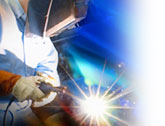
Building a NASCAR vehicle is not an assembly line process. Each competing team constructs vehicles according to their own specs, taking up to 4,000 hours to complete a single car or truck, says Bill Patterson, executive vice president, Richard Childress Racing Enterprises, Inc. (RCR).
The 29-acre RCR complex, located in the rolling hills of Welcome, North Carolina, includes three race shops, three engine shops, a research and development center for motors and chassis, paint and body shops, a parts department, a show car department, a museum, and a souvenir shop.
RCR is an established name in both the Winston Cup Series and the Craftsman Truck Series. Owner and former racer Richard Childress is celebrating his 30th anniversary in the business and is aiming for a seventh Winston Cup Championship as an owner in 1999. RCR operates two Winston Cup teams, a NASCAR Truck team, a show car program with 10 show cars, and a motorsport museum. His drivers include Dale Earnhardt, a seven-time NASCAR Winston Cup Series Champion and driver of the No. 3 GM Goodwrench Service Plus Chevrolet; Mike Skinner, driver of the No. 31 Lowe’s Home Improvement Warehouse Chevrolet and the 1997 NASCAR Winston Cup Series Rookie of the Year; and Jay Sauter, driver of the No. 3 GM Goodwrench Service Plus Chevy truck.
by: Diane Albrecht, product manager, Miller Electric Mfg. Co.
Welding’s Essential Function
Stringent pre-qualifying, post-qualifying, pre-race and postrace inspections by circuit officials ensure the safety of drivers and keep the highly competitive playing field level. Even though crews are allowed to continually tweak the machine for faster speeds, everything on the vehicle must meet NASCAR standards.
Of RCR’s 135 employees, 40 are welders who build up to 25 vehicles a year and perform repairs on another 60.
“Welding plays a significant role in building a racing vehicle from chassis to rearview mirrors,” says Adam Meyer, fabrication shop foreman. “Not only does the weld have to hold up under stress of the race, it needs visual approval from NASCAR inspectors who enforce the stipulation that the vehicles look like their passenger counterparts.”
For consistent, quality welds and metal cutting, the RCR team relies on Miller equipment, from plasma cutters at the track to MIG welders with boom wire feeders in the shop. RCR uses a variety of Miller products including Millermatic® 185 MIG welders, Syncrowave® 250 TIG welders, Spectrum® 300 CutMate™ plasma cutters, CP-252TS industrial MIG welders and Swingarc™ booms to mount wire feeders. “Our welders have been using Miller products for 25 years,” Meyer says. “We primarily weld steel, aluminum and chrome-moly steel. The metal thicknesses range from 1/4 inch down to 22 gauge (.030 in.).”
Where weld bead aesthetics are of primary concern, RCR fabricators use Miller CP-252TS MIG welders for steel, stainless steel and aluminum.
“Operators can more easily produce high-quality beads because this machine allows them to tailor the arc to match the application,” Meyer says. Five slope settings (volt/amp curves) offer the precise arc and puddle control required to make exposed welds attractive.
To facilitate the welders’ ease of movement around the vehicles, RCR uses the CP-252TS with Miller Swingarc semiautomatic wire feeders. The Swingarc boom-mounted semiautomatic wire feeders suspend over the work area, increasing the welders’ reach and maneuverability.
“Our welders like using the Swingarc because it gives them freedom to move around the vehicle. They also are able to get the job done more efficiently because they don’t have to move the power source,” Meyer says.
RCR also uses Millermatic 185 “All-In-One” MIG power sources. The Millermatic “All-In-One” features a power source, wire feeder, running gear, cylinder rack, gun and cable assembly in a compact 165-lb. package. This welder provides the versatility to weld everything from thin-gauge materials like car door skins to 3/8-in.-thick materials like fender aprons.
By adding the optional Spoolmate™ 185 wire feed spool gun to the Millermatic 185, the welding operator can run aluminum through the Spoolmate while keeping steel wire in the Millermatic 185’s built-in wire feeder. While the Spoolmate can run any type of wire, it is especially designed to feed aluminum wire smoothly and consistently. Its drive rolls are right at the gun where it feeds the wire approximately eight inches rather than forcing it to go through long gun linings where it could kink.
The Millermatic has up to 185 amps of output power and can weld mild steel, stainless steel and aluminum. It can make plug, butt, fillet and lap welds in all positions.
“The combination of versatility and price make the Millermatic 185 the perfect machine for building a race car,” Meyer says. “The machine was made for what we do.”
“NASCAR is becoming more popular nationwide,” Patterson says. “Television will boost it to the top. A lot of us thought that maybe racing hit a plateau, but it is not finished. NASCAR is going to keep growing stronger.”
© 2002 Miller Electric Mfg. Co